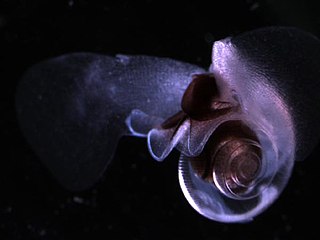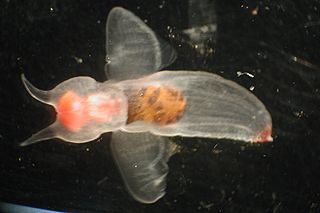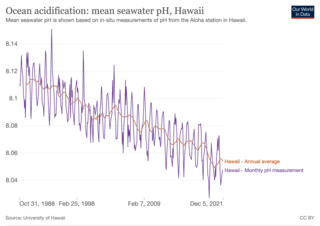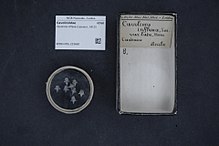
Sea butterflies, scientific name Thecosomata, are a taxonomic suborder of small pelagic swimming sea snails. They are holoplanktonic opisthobranch gastropod mollusks. Most Thecosomata have some form of calcified shell, although it is often very light and / or transparent.

Sea angels are a large group of small free-swimming sea slugs, not to be confused with Cnidarians, classified into six different families. They are pelagic opisthobranchs in the clade Gymnosomata within the larger mollusc clade Heterobranchia. Sea angels were previously referred to as a type of pteropod.
The mesopelagiczone, also known as the middle pelagic or twilight zone, is the part of the pelagic zone that lies between the photic epipelagic and the aphotic bathypelagic zones. It is defined by light, and begins at the depth where only 1% of incident light reaches and ends where there is no light; the depths of this zone are between approximately 200 to 1,000 meters below the ocean surface.

Limacina is a genus of swimming predatory sea snails commonly known as sea butterflies in the family Limacinidae. This genus contains some of the world's most abundant gastropod species.

The superfamily Cavolinioidea is the most speciose group of sea butterflies. They belong to the suborder Euthecosomata.
The Notobranchaeidae, or "naked sea butterflies", are a taxonomic family of floating sea slugs, specifically under the subclass Opistobranchia, also called "sea angels".

Paedoclione doliiformis is a species of sea angel, a small floating sea slug, a pelagic marine gastropod mollusk in the family Clionidae.

Pteropoda are specialized free-swimming pelagic sea snails and sea slugs, marine opisthobranch gastropods. Most live in the top 10 m of the ocean and are less than 1 cm long. The monophyly of Pteropoda is the subject of a lengthy debate; they have even been considered as paraphyletic with respect to cephalopods. Current consensus, guided by molecular studies, leans towards interpreting the group as monophyletic.

Ocean acidification is the decrease in the pH of the Earth’s ocean. Between 1950 and 2020, the average pH of the ocean surface fell from approximately 8.15 to 8.05. Carbon dioxide emissions from human activities are the primary cause of ocean acidification, with atmospheric carbon dioxide (CO2) levels exceeding 410 ppm (in 2020). CO2 from the atmosphere is absorbed by the oceans. This produces carbonic acid (H2CO3) which dissociates into a bicarbonate ion (HCO−3) and a hydrogen ion (H+). The presence of free hydrogen ions (H+) lowers the pH of the ocean, increasing acidity (this does not mean that seawater is acidic yet; it is still alkaline, with a pH higher than 8). Marine calcifying organisms, such as mollusks and corals, are especially vulnerable because they rely on calcium carbonate to build shells and skeletons.

The family Cavoliniidae is a taxonomic group of small floating sea snails, pelagic marine opisthobranch gastropod mollusks.

Clione limacina, known as the naked sea butterfly, sea angel, and common clione, is a sea angel found from the surface to greater than 500 m (1,600 ft) depth. It lives in the Arctic Ocean and cold regions of the North Atlantic Ocean. It was first described by Friderich Martens in 1676 and became the first gymnosomatous "pteropod" to be described.

Limacina helicina is a species of small swimming planktonic sea snail in the family Limacinidae, which belong to the group commonly known as sea butterflies (Thecosomata).

Limacina rangii is a species of swimming sea snail in the family Limacinidae, which belong to the group commonly known as sea butterflies (Thecosomata).
Limacina retroversa is a distinct species of swimming planktonic gastropods, belonging to a group of predatory sea snails known as sea butterflies (Thecosomata). The name Limacina retroversa describes the unique morphology of this sea snail, including its slug-like body and coiled, backwards-turning shell. They are typically found in the epipelagic zone of cold, polar waters, but can be found worldwide, in any ocean. L. retroversa are currently under threat, as their numbers are decreasing due to rising global carbon levels and other human-caused climate threats.

The Arctic ocean covers an area of 14,056,000 squared kilometers, and supports a diverse and important socioeconomic food web of organisms, despite its average water temperature being 32 degrees Fahrenheit. Over the last three decades, the Arctic Ocean has experienced drastic changes due to climate change. One of the changes is in the acidity levels of the ocean, which have been consistently increasing at twice the rate of the Pacific and Atlantic oceans. Arctic Ocean acidification is a result of feedback from climate system mechanisms, and is having negative impacts on Arctic Ocean ecosystems and the organisms that live within them.

Human activities affect marine life and marine habitats through overfishing, habitat loss, the introduction of invasive species, ocean pollution, ocean acidification and ocean warming. These impact marine ecosystems and food webs and may result in consequences as yet unrecognised for the biodiversity and continuation of marine life forms.
Joan Ann ("Joanie") Kleypas is a marine scientist known for her work on the impact of ocean acidification and climate change on coral reefs, and for advancing solutions to environmental problems caused by climate change.

Diacria trispinosa is a holoplanktonic species of gastropods belonging to the family Cavoliniidae. It is classified as a mesoplankton.
A micronekton is a group of organisms of 2 to 20 cm in size which are able to swim independently of ocean currents. The word 'nekton' is derived from the Greek νήκτον, translit. nekton, meaning "to swim", and was coined by Ernst Haeckel in 1890.
Clione okhotensis is a species of sea angel, a pelagic marine gastropod in the family Clionidae.










